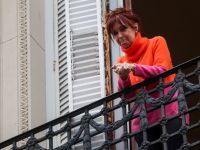Anyone living in or visiting Muscat in the next few months will have the chance to witness an operatic treat, with London’s Victoria & Albert Museum bringing its immersive exhibition to the Omani capital.
Those not already passionate about opera surely will be by the time they finish strolling through “Opera: 400 Years of Passion,” a storytelling exhibition curated by V&A senior curator Kate Bailey, looking at pivotal moments, composers and productions in opera over the last four centuries.
The show marks the inaugural exhibition at the Royal Opera House of Muscat’s newly launched venue, the House of Musical Arts. It is also the first stop on the exhibition’s world tour since the V&A premiered it in London in 2017.
“It will transport you to the glamorous societies around five operatic premieres, in five European cities - Venice, London, Paris, Milan and Vienna - shining a light on this most innovation, dramatic and beautiful of art forms, from the Renaissance to present day,” V&A deputy director Tim Reeve told The Daily Star. “The exhibition in Muscat includes a new specially created finale, which celebrates opera in Oman, highlighting the opening of the ROHM in 2011 with a world class production of Puccini’s ‘Turandot.’”
In every new country the show visits, the finale will change to reflect that nation’s relationship with opera.
Founded in 1852, the V&A is among the most prestigious arts and designs institutions in the world, with 5 billion people in 40 countries having visited their shows in the last three years alone.
“This is a story that will truly resonate across the world with over 160 objects, many from the V&A’s own collections complimented by loans from 18 lenders from Italy, France and U.S,” Reeve said. “It includes an array of exquisite objects, including a beautiful Venetian harpsichord, 18th-century theater costumes, Huguenot silver and a [signed] Verdi score from ‘Nabucco.’ Some of these objects have never left Europe before.”
This show, which Bailey began researching in 2012, is a response to the explosion of new opera houses popping up around the world - one of which was the ROHM.
“It’s an amazing story that should be told more broadly and tied to demystify opera, unpack it for people who are not opera aficionados and make it more accessible to a broader audience,” Bailey told The Daily Star. “You’re looking at how opera moves through time and how it speaks to the society in which it’s created.”
Entering the exhibition with a personal sound guide created by Sennheiser, visitors are greeted with the serene duet “Pur ti Miro” from Montiverdi’s “L’Incoronazione di Poppea,” first performed in Venice in 1642.
Props, china and vases from the 1500 are displayed in glass cases and a crimson velvet gown used in a production of “Les Fete Venitiennes” in the 1600s.
“[We have] a musical soundtrack that as you move though the different cities, a triggering system changes the track depending on where you are; you’ll move through and hear a different excerpt,” Bailey explained, “which we’ve chosen depending on what you’re seeing.
“Beginning in Venice, its where opera becomes an art form for the people, for the city - before that it was in the courts - and in Venice it becomes this new popular entertainment,” she said. “In London we look at how it’s at this time in 1711 when London is emerging as a world city and it takes this European art form.
“We have this German composer [Handel] writing in the Italian language for a British audience and that narrative is fascinating because you see that [opera] wasn’t always supported,” Bailey continued, “there’s interesting criticism from a spectator in 1711 that says ‘what’s this exotic European thing?’”
Moving to the Vienna section, the tale focuses of Mozart going to city of enlightenment, where he writes “Le Nozze di Figaro” in 1786, an opera taking on contemporary look for the first time.
“We have a fantastic bit of interpretation in the Mozart section where Antonio Poppano from the London Opera House explains Mozart’s practice,” Bailey said. “The audience for the first time see themselves on the stage - it’s not a story from the classics or Rome, it’s a story of now by a young, ambitious composer.
Among the artifacts and original reviews, sheet music and costumes is a replica of a 1788 pianoforte similar to the one Mozart played.
“Then we arrive in Milan with Verdi’s ‘Nabucco,’ so here you’re looking at La Scala being right at the center of Italian culture and how this opera unites Italian society, which at the point was under Austrian rule,” Bailey said. “Then we look at Paris and how the Paris Opera House was part of the master plan of the new city.
“We look at Wagner, who is in exile at this point, but writes the operas for Napoleon and it shows that with this opera [‘Tannhauser,’]” she added, “it’s not always popular when it first happens - there’s a bit of friction because the music is too modern.
The final section in Muscat focuses on the ROHM’s first show, Puccini’s “Turandot,” showcasing the elaborate costumes, models of the auditorium and recordings of the “Nessun Dorma” scene to watch and listen to. The formation of the Omani Royal National Symphony Orchestra is also detailed, with traditional instruments on display.
“Opera: 400 Years of Passion” is up at the ROHM House of Musical Arts until March 14.
This article has been adapted from its original source.








